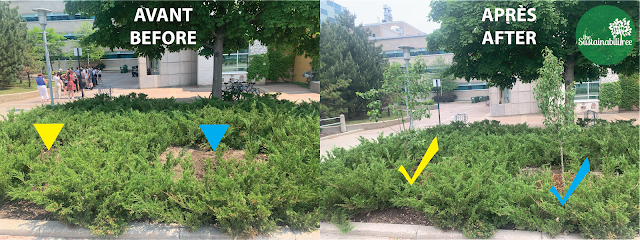Years ago, I attended the World Urban Forum (WUF) in Vancouver. WUF is a gathering of groups who are obsessed with urbanism and how, if done correctly, it could help solve many of the world's problems.
The gathering, hosted by the United Nations, really is a geekfest of policy ideas, new technologies, and networking opportunities. But the thing that really caught my eye while I was there was an installation representing an Edible Landscape.
For those who don't know, an edible landscape is basically a garden where all the plants are switched for edible varieties. By doing this, people can grow food and have a lovely garden aesthetic (existing in harmony rather than in opposition).
Fast forward a bit more than a decade and edible landscapes are starting to take root at uOttawa. In 2021, the Office of Campus Sustainability started filling some planters on campus with edible plants instead of the traditional non-edible ones. An extension of the community gardens, the edible landscapes provide food that is harvested and donated to volunteers and local food banks.
In 2022, a few more spaces where added and more varieties of food were grown; including, peppers, tomatoes, kale, swiss chard, and beans. We even had some raspberry bushes producing berries.
But this year, the edible landscape concept is being taken to the next level with the introduction of some fruit trees. Thanks to a grant secured by dedicated volunteer Victoria King (who also secured funding for a pollinator garden last year), ten fruit trees were planted on campus this spring (four pear trees and six apple trees).
The original plan was to have all the trees in one area, but due to some unexpectedly rocky soil conditions, the trees had to be split up and planted in groupings on campus. The trees were planted in pairs, to ensure that they could cross-pollinate, but the dream of having them concentrated in one area was simply not possible. So even though our food forest isn't all in one place, the basic concept is still there.
And what is a food forest? Well if you haven't already guessed it is an extension of the edible landscape concept which replaces other trees with fruit-bearing ones. The fruits can be harvested to feed people, while all the ecological benefits of having a tree are maintained.
There is also the potential to use the food forest as a learning opportunity for the community, as well as grow the size of our forest if this pilot is successful. Could these trees produce an adequate amount of food to nourish some communities around campus? Will they attract a good number of pollinators?
Only time will tell, but for now, this next step in creating an edible landscape at uOttawa is creating a lot of excitement.











Comments